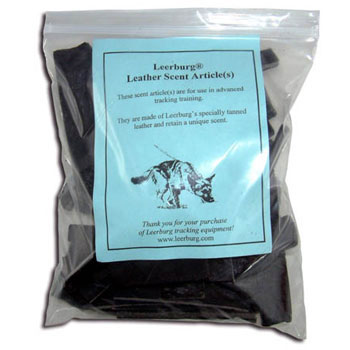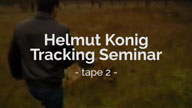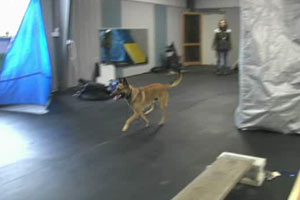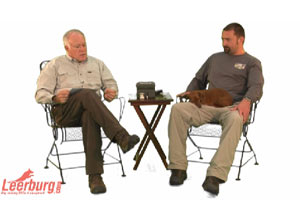S&R - Working Dogs and Dead Bodies
Ed's Note: I have been involved in several searches for dead bodies. A couple of years ago my dog tracked a gunshot suicide in the woods at night. I was surprised at the reaction my very tough police dog gave when he found the person under a tree—very cautious. Several weeks ago, another of our new K9 handlers (with a young bloodhound) missed a body that was frozen solid under 6 inches of snow. Just as I arrived on the scene with my dog, one of the deputies actually stepped on the body so I was not able to get my dog out to look for it.
I discussed this bloodhound situation with my friend Gary Murray. Gary worked as a K9 handler for many years with the RCMP in Canada. In my opinion the RCMP is the best in the world at country tracking. I asked Gary to write a small article for the web and detail our conversation. Here is what he had to say. —Ed Frawley

Training a dog in a search profile for missing persons, and or evidence search is really very basic. The key element is getting the dog to search and indicate human scent. How the dog is taught this and how the dog indicates this varies from trainer to trainer and handler to handler. But the profile in a nut shell is, search for human scent, pinpoint it to the source, and indicate this to the handler. So you can train for the missing person search and also teach the dog to indicate anything that has human scent on it (articles, evidence). The part of this profile you can't train for is the dead body.
The new dog handler is now thinking my dog will indicate a dead body no problem. I've done tons of training and we've even located some missing persons or I've found lots of people hiding in compounds he'll never miss a dead body. Besides with all that scent coming off the body there is no way the dog will miss a dead body.
Well you're partly right, the dog will smell the body, he will also indicate the body, but will you read the indication right?
Let's discuss scent and just what the dog is doing when you are searching for a missing person and the person is alive. A live subject is constantly giving off human scent. This scent is there and available to the dog and therefore easy for the dog to locate and indicate if he/she is properly trained. While the person is alive this giving off of human scent is also saturating the clothes that the person is wearing. So now we have a walking, talking article full of human scent.
While you are alive the human scent factor is at its peak. The second that you die your body starts to decompose. The rate of this decomposition varies with the body location and climatic conditions it is exposed to. (Something to keep in mind). Once you start decomposition the body starts to give off an animal scent. Now keep in mind that 1) we are animals 2) when you die for lack of a better term you are just human meat.
Once the body dies the human scent factor starts to drop and the animal scent factor starts to rise. The rate of this will depend on the rate of decomposition. But the two factors are inversely proportionate to each other and over time they exchange places. After time the animal scent overpowers the humans scent.
So having trained our dogs to indicate human scent through all their training, corrected them for indications on live animals (cats, wildlife, other dogs, etc.), dead animals (cats, wildlife, other dogs, etc.) and animal urine and feces spots. You can see where a problem can develop with a missing person search and you are dealing with dead body.
The first thing I want you to do is stop thinking like a human and think like a dog.
Experienced dog handlers will tell you that there is an indication, it is just different from what you are used to seeing. Depending on the age of the body the indication will be some form of a combination of your dogs human indication and the animal indication. Because the body will be giving off both scents your dog will be a bit confused and this will show in his/her indication.
Lots of time it is the clothing that first gets the dogs attention scent wise, (they are saturated with human scent). As the dog works into the scent cone and gets closer to the body the animal scent will come into play and this will confuse the dog and will show in the indication. The head may drop, hackles may come up, the white of the eye may show, (I know I'm not supposed to indicate this but...) If you are using a police dog that is attack trained for SAR you have to watch your dog when he/she indicates because you may be surprised as to how they indicate.
I was working in British Columbia and was doing a search for a suspected suicide with Gary McCormick. Gary was working his dog and had just finished training and certifying the dog with in the last year. The dog had never been around a dead body before. The dog indicated the body from about 50-60 feet as he ran through the scent cone. As he turned up into the wind and the scent cone the indication changed from "I've got something Dad" to "What the..." The dog worked straight up the scent cone towards the body, his head dropped, hackles came up and he started to growl when he got within about 20 feet of the body. He then started to circle the body and as we started to approach the dog attacked the body and had to be called off.
I have heard and seen this happen to a lot of Police dogs used for SAR. Dogs that are trained strictly for search and rescue will probably not attack but they are going to give a strange indication the first dead body they come upon.
On older bodies that the animal factor is quite high I have had dogs "mark" the body or if the body has been removed and I was called in to do an evidence search the dog will "mark" where the body had been located.
So if you are searching for a body that you think is dead bear this in mind if you have not located a dead body with your dog before. Explore any and all indications. When and if you locate the body observe your dog and memorize that indication you are going to need it. Any chance you get to take your dog around a dead body do so and observe the indication. Use this as a training situation, but bear in mind not to destroy any evidence just to train your dog.
The bottom line is you can train as real as you want but some things you have to experience first hand to know how your dog is going to react. You can't train for dead bodies you have to work real cases to get that kind of experience.









Ask Cindy.